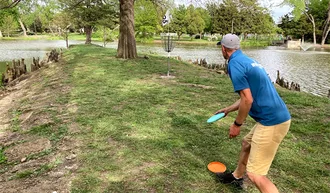Last updated on January 29th, 2024 at 04:07 pm
Last updated by Simon
When most of us started playing disc golf we started hearing new terminology that we weren’t familiar with. Words like ‘overstable’, ‘flippy’, ‘mando’, and others started creeping into our vocabulary. We’re going to discuss two such words today: hyzer and anhyzer.
While much of the language in disc golf comes from ball golf, words that describe the flight of the disc are unique to disc sports. The words ‘hyzer’ and ‘anhyzer’ are two examples of disc flight terms. Let’s take a look at both of those words and learn exactly what them mean in disc golf.
Hyzer vs. Anhyzer: What is the Difference?

The words ‘hyzer’ and ‘anhyzer’ refer to the angle of the disc when it leaves the hand of the thrower. Let’s say someone throws with their right hand and they throw backhand shots (know as ‘right-hand backhand’ or RHBH). If the disc is horizontal when it leaves their hand, it is neither hyzer nor anhyzer. It is flat. If the disc is not flat when it leaves the throwers hand, it is some degree of hyzer or anyhyzer. Let’s look at those terms separately. We’ll define them and explore when they might be used.

What is Hyzer?
As mentioned before, if a disc leaves your hand on a backhand throw and it is flat, then it doesn’t have a hyzer/anhyzer angle. But, if the side that is farthest from you is lower than the side that is closest to you when you are releasing the disc, it is said to be on a hyzer angle, or ‘on hyzer’.

There are several reasons that someone might throw a hyzer shot. They might need the disc to get around an object and finish left. A hyzer shot will help the disc cut a sharper corner, since it is already at an angle to help it go hard to the left. If you are throwing an understable disc, which has a tendency to turn to the right as it leaves your hand, and you throw it on a hyzer angle, the disc can instead roll to the right and become flat and fly a long way. That is called a hyzer-flip.
You might find yourself in a situation where you want the disc to land nearly vertical so it spikes into the ground and doesn’t skip away. In that case you might want to throw a hyzer on a really steep angle with a throw called a spike hyzer. Or maybe you DO want your disc to get a good skip off the ground. Throwing an overstable disc hard and with a little hyzer can give you the ground action you’re looking for.
The hyzer shot has a lot of versatility and it is something that beginners can work on. By bending slightly at the hips on your drive, your body is in a good position for the hyzer angle throw. As your form improves, you will find yourself hyzer-flipping your discs more often and getting the long flight associated with that throw.
It’s important to keep in mind the effect that the wind has on a disc that was thrown on a hyzer angle. A wind blowing right to left (on a RHBH throw) will catch the flight plate and push the disc far to the left. That can even happen with a flat release, when the disc starts to fade.
If the wind is blowing left to right, it will push the disc to the ground quickly. In a strong wind it can be difficult to get the flight you want with a hyzer shot.
What is Anhyzer?
The anhyzer shot is the opposite angle of the hyzer. When the disc leaves your hand on a hyzer angle, the far edge of the disc will be higher than the closer edge. The anhyzer throw is commonly called an ‘anny’ shot in disc golf.

The anhyzer can also be a useful tool in your arsenal. If you throw a stable disc on an anny angle the disc will be forced to curve to the right initially, until the stability of the disc takes over and it curves around to the left. It’s a good way to either get the disc to turn right while throwing a backhand shot, or maximize your distance down the fairway. That kind of shot is known as a flex shot because you are forcing the disc to fly a certain way until it ‘flexes’ its stability and finishes in a different direction.
An anhyzer shot can also be used successfully in a tailwind. If thrown in a headwind the anny shot can turn too much to the right and crash to the ground because of the added affect of the wind. With a tailwind, however, the wind doesn’t make the disc turn to the right as much, so the disc has time to make its complete flight, finishing with a fade to the left.
Roller shots can also be helped initially by throwing on an anhyzer angle. If done properly, the disc will continue to turn to the right until it hits the ground on an angle and rolls down the fairway. The direction of the spin of the disc actually helps the roller zip along the ground.
Conclusion
Getting to know about hyzer and anhyzer shots, what they are and when to use them, will help you progress along your disc golf journey. Take some discs to a field and practice throwing different angles and you will learn how your discs fly and can see when you might use those shots. Check out these links for more instruction and some videos about hyzer shots here: Learning the details of the hyzer
Happy hucking!

